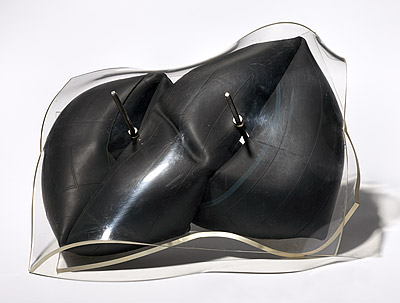Hilary
ARCHER
India
1934
Australia from 1949
Tubeseed (A)
1972
synthetic polymer, moulded rubber tube, steel nuts and bolts
3.1982.197
(not signed, not dated)
inscribed in black felt tip pen on label centre back: PLEASE DO NOT EXHIBIT IN THE/SUN./SIMPLE TO CLEAN. JUST UNSCREW/INFLATE GENTLY WITH PUMP/signed "HILARY A" (not dated)
32.2 (h)
x 51.2 (w)
x 52.0 (d)
cm
Gift of the Philip Morris Arts Grant 1982
National Gallery of Australia, Canberra
NGA 1983.1599
Hilary Archer creates a combine object which brings together a rubber inner tube, acrylic and metal fittings. Partially inflated, twisted in a figure eight, the tube is sandwiched between two clear sheets that have been moulded around the rubber form. The acrylic is held in place with two bolts that seem overlong for their job. On the one hand they provide the object with a greater three-dimensionality; on the other they allow it to be set at an angle, or to pivot on two ‘feet’.
Despite the fact that all the elements of Tubeseed (A) are manufactured, there is a curious sense of the organic, of a growing entity which seems to push out of its ‘shell’. The overall shape of the rubber tube is reminiscent of a seed or bean—inevitably the whole structure recalls a flower-press, a specimen case or a prized butterfly pinned in a box. Larger than life but able to be comfortably held, the tube-which-is-now-a-seed incorporates a sense of anticipation: what would happen if it did expand or start to grow? Are the bolts extra long to accommodate expansion? Tubeseed (A) has the mystery and illogicality of a Dada object, or one of Surrealism’s chance encounters of unrelated items.
The artist’s summation provides a more personal, biographical reading: ‘There is more to the work than meets the eye … In the 1970s I was feeling the sexual repression of being a wife and mother so the sexy black inner tube was a portrait of me, like the soft centre of a chocolate, squashed by a slightly giving vice of clear plastic and some unbending screws.’[1] Archer has signed and inscribed the work underneath: ‘please do not exhibit in the sun’. Her instruction is practical―since rubber and acrylic deteriorate when exposed to ultraviolet rays―but there is, perhaps, also another warning here.
Lucina Ward
Curator,
International Painting and Sculpture
National Gallery of Australia, Canberra
[1] Letter from Hilary Archer, dated 18 February 2009, to the Gallery, NGA file 87/0338. folio 11

